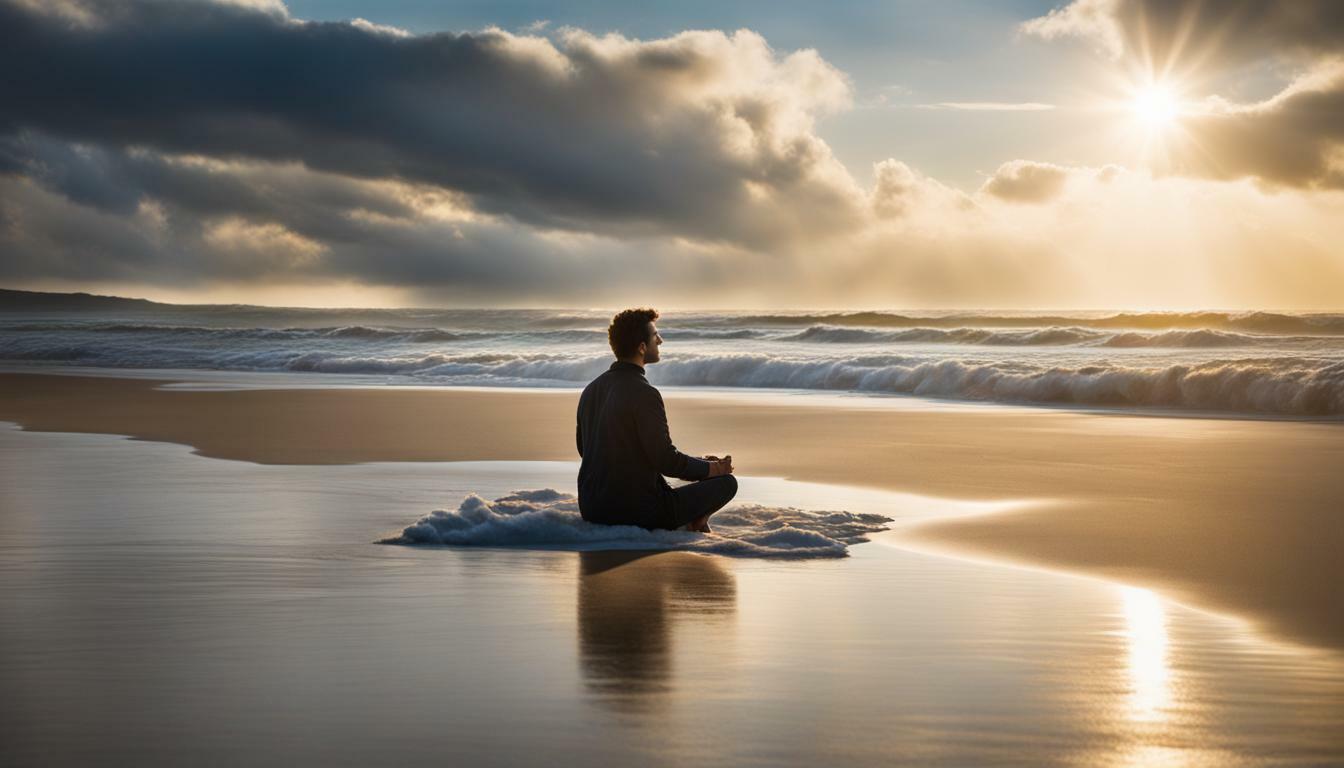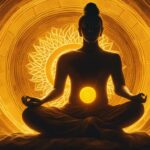Meditation is a powerful practice that can bring peace and tranquility to your life, and learning how to master it is essential in today’s hectic world. As we navigate the fast-paced nature of modern living, it becomes increasingly important to find moments of stillness and connection within ourselves. Meditation offers a pathway to cultivate mindfulness, reduce stress, and unlock transformative benefits that can positively impact every aspect of our lives.
Key Takeaways:
- Mastering meditation is essential for finding tranquility in today’s busy world.
- Meditation helps cultivate mindfulness and awareness of the present moment.
- Creating a dedicated meditation space enhances the meditation experience.
- Proper posture and breathing techniques are crucial for deepening meditation.
- Mudras, hand gestures, can enhance meditation and direct energy flow.
Understanding the Fundamentals of Meditation
To master meditation, it is important to understand the fundamentals of this ancient practice and how it can positively impact your well-being. Meditation is not just about sitting in silence; it is a tool for cultivating mindfulness and awareness of the present moment. By incorporating meditation into your daily routine, you can unlock tranquility and experience a range of transformative benefits.
One of the key aspects of meditation is creating a dedicated and peaceful space for your practice. Find a quiet corner in your home where you can relax and let go of distractions. This space should be clean, clutter-free, and inviting. Consider adding elements like candles, cushions, or a soothing soundtrack to enhance the ambiance.
Posture plays a crucial role in meditation. By sitting with a straight back, you allow for deeper breathing and improved focus. Find a comfortable position, whether it be on a cushion, a chair, or on the floor. Experiment with different postures and find the one that works best for you.
There are various techniques and styles of meditation to explore. Mindful meditation, for example, involves focusing your attention on the present moment without judgment. Guided meditation practices can provide support and guidance, especially for beginners. These practices often involve visualization exercises that help you relax and enter a meditative state.
To further enhance your meditation practice, consider incorporating mudras. Mudras are hand gestures that can help maintain focus and direct the flow of energy. For example, Gyan Mudra, where you touch the tip of your index finger to the tip of your thumb, is believed to enhance knowledge and wisdom. Prana Mudra, on the other hand, involves touching the tips of your ring finger and little finger to your thumb and is thought to increase vitality and life force.
To summarize, mastering meditation is a lifelong journey that brings profound benefits to your physical, mental, and emotional well-being. By understanding and applying the fundamentals of meditation, creating an optimal meditation space, mastering posture, and incorporating techniques like breath awareness and guided meditation, you can unlock tranquility and inner peace.
Table: Mudras and Their Benefits
| Mudra | Benefits |
|---|---|
| Gyan Mudra (Knowledge Mudra) | Enhances knowledge and wisdom |
| Prana Mudra (Life Force Mudra) | Increases vitality and life force |
Creating an Optimal Meditation Space
Creating the right environment for meditation can greatly enhance your practice and promote a sense of tranquility and relaxation. Whether you are a beginner or an experienced meditator, having a dedicated space for your practice can make a significant difference in your ability to focus and cultivate mindfulness.
When setting up your meditation space, consider choosing a quiet and serene area in your home where you can minimize distractions. This could be a corner of a room, a spare room, or even a cozy nook in your garden. Make sure the space is clutter-free and clean, as this will help create a sense of calm and serenity.
You can further enhance the ambiance of your meditation space by incorporating elements that promote relaxation. Adding soft lighting, such as candles or Himalayan salt lamps, can create a soothing atmosphere. Consider using essential oils or burning incense to stimulate your senses and create a calming aroma.
Table: Essential Elements for an Optimal Meditation Space
| Element | Benefits |
|---|---|
| Comfortable Cushion or Mat | Provides support and comfort during meditation |
| Nature-inspired Decor | Creates a grounding and harmonious atmosphere |
| Quietness | Minimizes distractions and promotes deep focus |
| Soft Lighting | Induces relaxation and soothes the mind |
Once your meditation space is set up, it’s essential to establish a consistent routine. Allocate a specific time each day for your practice and commit to it. Consistency is key to progress in meditation, as regularity helps train the mind and body to enter a meditative state more easily.
Remember, creating an optimal meditation space is not about having a lavish or extravagant setup. It is about creating a space that resonates with you and supports your meditation practice. By dedicating a tranquil spot in your home and incorporating elements that promote relaxation, you can create an environment that fosters deep inner peace and mindfulness.
Mastering Posture and Breathing Techniques
Mastering the art of meditation requires understanding the significance of posture and breathing techniques in achieving a state of peace and tranquility. Proper posture allows for deeper breathing, which helps to calm the mind and enhance focus. By maintaining an upright position with the spine straight, you create a solid foundation for your meditation practice.
One effective technique is breath awareness meditation, where you focus your attention on the breath as it naturally flows in and out. As you become more aware of your breath, you begin to cultivate a sense of inner calm and presence. Guided meditations with visualization can also be beneficial, as they provide guidance and support in directing your attention and deepening your practice.
Consistency and patience are key in mastering posture and breathing techniques. Set aside a dedicated time and space for your meditation practice, where you can be free from distractions. Create a serene environment by adding elements such as candles, cushions, or soft lighting. Experiment with different postures, such as sitting cross-legged on the floor or using a meditation stool or cushion, until you find what feels most comfortable for you.
Benefits of Proper Posture and Focused Breathing:
- Improved focus and concentration
- Reduced stress and anxiety
- Enhanced relaxation response
- Deeper connection with the present moment
- Increased self-awareness and self-acceptance
Incorporating mudras, or hand gestures, into your meditation practice can further deepen your experience. Mudras help maintain focus and direct the flow of energy within the body. One commonly used mudra is the Gyan Mudra, where the tip of the thumb touches the tip of the index finger, symbolizing knowledge and wisdom. Another beneficial mudra is the Prana Mudra, formed by joining the thumb, ring finger, and little finger, which enhances the life force and vitality within.
| Mudra | Benefits |
|---|---|
| Gyan Mudra | Enhances concentration and memory |
| Prana Mudra | Boosts energy and vitality |
When incorporating mudras into your meditation practice, it is important to align your intent with your actions, infusing each gesture with focused awareness. As you continue on your meditation journey, remember that it is a lifelong practice that brings profound benefits to your life. Embrace the journey, be patient with yourself, and allow meditation to unlock the tranquility that resides within.
Enhancing Meditation with Mudras
Discover how mudras can enhance your meditation practice and bring additional benefits to your journey of mastering meditation. Mudras are hand gestures that have been used for centuries to channel and direct energy flow within the body. By incorporating mudras into your meditation practice, you can deepen your focus, amplify intentions, and experience a greater sense of peace and tranquility.
Mudras work by activating specific energy points in the hands, which are connected to different areas of the body and mind. Each mudra has its own unique benefits, allowing you to tap into different qualities and states of being. One powerful mudra is Gyan Mudra, also known as the “mudra of knowledge.” By touching the thumb and index finger together, you can enhance concentration, wisdom, and clarity during your meditation.
Another beneficial mudra is Prana Mudra, the “mudra of life force.” This mudra involves touching the ring finger and little finger to the thumb while keeping the other fingers extended. Prana Mudra helps to activate and balance the vital energy within the body, promoting vitality, rejuvenation, and a deeper connection to your life force.
| Mudra | Benefits |
|---|---|
| Gyan Mudra | Enhances concentration, wisdom, and clarity |
| Prana Mudra | Activates vital energy, promotes vitality, and rejuvenation |
To incorporate mudras into your meditation practice, begin by finding a comfortable seated position, ensuring your spine is aligned and relaxed. Close your eyes and bring your attention to your breath. When you feel centered and grounded, gently bring your hands into the chosen mudra, holding it for the duration of your meditation.
Remember, while mudras can enhance your meditation practice, the true essence of meditation lies in your consistent and patient exploration of the present moment. Embrace the journey of mastering meditation and allow these ancient hand gestures to deepen your connection with your inner self.
Conclusion
Embark on the journey of mastering meditation today and unlock a world of peace and tranquility in your life. In today’s fast-paced world, meditation is essential for finding inner calm and reducing stress. By cultivating mindfulness and awareness of the present moment, you can experience transformative benefits that extend beyond your meditation practice.
Creating a dedicated meditation space is crucial in enhancing your experience. Find a quiet and serene environment where you can fully immerse yourself in the practice. This will provide the ideal setting for deepening your meditation and finding a sense of serenity amidst the chaos of daily life.
Mastering posture and breathing techniques is another key aspect of meditation. By maintaining proper posture, you can facilitate deeper breathing and improve your focus. Consistency and patience are key in this journey, as mastering meditation takes time and practice. Explore different techniques, such as breath awareness meditation or guided meditations with visualization, to find what resonates with you.
Additionally, consider incorporating mudras, hand gestures, into your meditation practice. Mudras can help maintain focus and direct the flow of energy within your body. Explore different mudras, such as Gyan Mudra for knowledge or Prana Mudra for life force, to enhance your meditation experience. Remember, incorporating mudras is about aligning your intent with your actions.
Embarking on the journey of mastering meditation is a lifelong endeavor, but the benefits it brings to your life are immeasurable. Reduced stress, improved focus, and a greater sense of inner peace are just some of the transformative effects you can expect. So, take the first step today and unlock the tranquility that meditation offers.
Can Orgasmic Meditation Help in Achieving Tranquility?
Can orgasmic meditation help in achieving tranquility? To find out, learn about orgasmic meditation today. This ancient practice has gained popularity for its potential to increase mindfulness, reduce stress, and enhance overall well-being. By nurturing the mind-body connection, orgasmic meditation may offer a unique pathway to tranquility and inner peace. Discover its principles, benefits, and techniques to embark on a transformative journey.
FAQ
Why is mastering meditation essential in today’s fast-paced world?
Mastering meditation is essential because it helps cultivate a calm mind and reduce stress in our fast-paced world. It unlocks transformative benefits and allows us to find a sense of tranquility amidst the chaos.
What are the fundamentals of meditation?
The fundamentals of meditation involve cultivating mindfulness and awareness of the present moment. It is about being fully present and non-judgmentally observing our thoughts, sensations, and emotions.
How can I create a peaceful meditation space?
To create a peaceful meditation space, find a quiet and serene environment where you can practice without distractions. Add elements such as soft lighting, comfortable seating, and calming scents to enhance the experience.
Why is posture important in meditation?
Posture is crucial in meditation because it allows for deeper breathing and a focused mind. Maintaining an upright and relaxed posture helps to align the body’s energy and promotes a sense of groundedness.
What are some beneficial meditation techniques?
Breath awareness meditation is a beneficial technique where you focus on your breath to cultivate mindfulness. Guided meditations with visualization can also be helpful, as they provide guidance and imagery to deepen your practice.
How long does it take to master meditation?
Mastering meditation is a lifelong journey, and the timeline varies for each individual. Consistency and patience are key. With regular practice, you will gradually experience the benefits and deepen your meditation skills over time.
How can mudras enhance my meditation practice?
Mudras are hand gestures that can enhance meditation by maintaining focus and directing energy flow. Different mudras, such as Gyan Mudra for knowledge and Prana Mudra for life force, offer unique benefits when incorporated into your practice.
What is the overall purpose of meditation?
The overall purpose of meditation is to cultivate a calm and focused mind, reduce stress, and unlock profound benefits in all aspects of life. It is a journey of self-discovery and inner peace.








